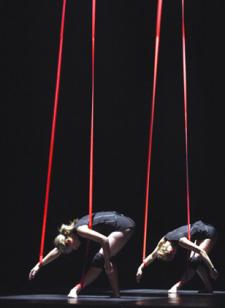 |
Mercy photo Michael Rayner |
The idea for Mercy: a dance for the forgotten came to New Zealand choreographer Raewyn Hill after a visit to Port Arthur in 2005 and her subsequent readings of Margaret Scott’s Port Arthur, A Story of Strength and Courage. The work is an exploration of imprisonment, torture and pays homage to the strength of the human spirit in times of adversity.
Mercy’s stylistic strength comes from stark symbolic components – red ribbons and blindfolds are worn by the dancers who struggle against prison guards as they are led to their likely deaths. Chains, attached to male dancers are dragged noisily across the hazy stage. The costumes are black, tightly fitted corsets and large, layered skirts reminiscent of colonial underskirts. The lighting evokes prison life with bars and small isolated cells and downward lights creating, at times, a sense of a God looking down on the prisoners as they repent and seek salvation.
It is said in moments of struggle humans look for connection – often a physical one. There are such moments, but the audience is denied any fulfilling emotional journey alongside these convicts or prisoners. For a moment, love does emerge, between two captivating dancers – Trish Dunn and Derrick Amanatidis. They support each other’s bodies, caress gently and we know their love will never be fully realised in such a treacherous place.
At times the work is unrelenting in its motifs of oppression, however the mood achieved through the choreography leans more towards the abstract than the specifics of a monumental time in our national history. The work seems therefore to be limited conceptually and doesn’t achieve the promise of the program synopsis.
The musical score (Pergolesi’s Marian Vespers composed more than 250 years ago) is astounding, strong and impassioned and operatic – it seems to call the lost souls of the prisoners to the stage to repent and free their souls. Choreography and musical score are given a similar weight for much of the work and on occasion the music seems distracting.
Mercy is a stylish work, visually arresting with strong symbolism but perhaps too abstract in its treatment of its subject matter to be completely fulfilling.
Tasdance, Mercy: a dance for the forgotten, choreography & conceptual design Raewyn Hill, dancers Floeur Alder, Trisha Dunn, Derrick Amanatidis, Malcolm McMillam, James Shannon, Tanya Voges, costume & set design Greg Clarke, lighting design Daniel Zika; Theatre Royal, Hobart, Ten Days on the Island, March 22-24
Magdalena Grubski is a producer, marketeer and publicist. As well as free-lancing, she works full time for Tasmania’s Is Theatre.
© Magdalena Grubski; for permission to reproduce apply to [email protected]








 back
back